On this page
21 Duel Blackjack
On this page
Introduction
21 Duel Blackjack is a blackjack variant by Playtech. It is difficult to compare 21 Duel Blackjack to any other existing game so please see the rules below for more information.
Top 4 Playtech casinos View All
Rules
- Six 52-card decks are used.
- Cards and hands are scored as in blackjack, except a blackjack is just 21 points and equal to 21-point hands composed of three cards.
- Play starts with the player making an Ante bet and an optional 2 Up side bet.
- The game will then deal the player two cards, one face up and one face down, the dealer two cards face down, and two community cards.
- At this point, the player has following three options:
- Fold and lose the Ante bet.
- Select the LEFT card to combine with the player's face up card and make a Raise bet equal to the Ante bet.
- Select the RIGHT card to combine with the player's face up card and make a Raise bet equal to the Ante bet.
- Unless the player has 21 points at this point, the player may hit or stand. If the player hits, then the face down card dealt to him earlier will be revealed and added to his hand. If the player stands, then the player's face down card shall be discarded. If the player has 21 points after two cards, then he automatically stands.
- If the player hits and goes over 21 points, then the player shall lose the Ante and Raise bets.
- After the player's turn, the dealer shall go through the same steps, using the same two community cards as the player. The dealer's decision on which community card to select is explained in the house way below. The dealer's hit or stand decision is to hit on 16 or less and stand on 17 or more.
- If the dealer goes over 21 points, then the player shall win 1-1 on the Ante and Raise bets.
- Otherwise, if the dealer has 12 or less points, then the dealer shall not qualify and the player will automatically win 1-1 on the Ante and push on the Raise, regardless of the player total.
- Otherwise, the hand with more points shall win. IF the dealer has more points, the Ante and Raise bet lose. If the totals are equal, then the Ante and Raise bets shall push. If the player has the higher total, then the player shall win 1-1 on the Ante and Raise.
- The 2 Up side bet pays based on the player's first card and the two community cards. It pays 20 to 1 for a three of a kind and 3 to 1 for a pair.
House Way
The dealer shall play the first available hand on the following list.
- 21
- 20
- 19
- 11
- 10
- 9
- 18
- 17
- Soft 16
- Soft 15
- Soft 14
- Soft 13
- Soft 12
- 8
- 7
- 6
- 5
- 12
- 13
- 14
- 15
- 16
- 4
Example

Here the player bet $25 and my first card is a 9. The player's second card can be either a jack or 2, for a total of 19 or 11. The strategy table for a starting 9 shows the better play is to select the 2, so the player did.
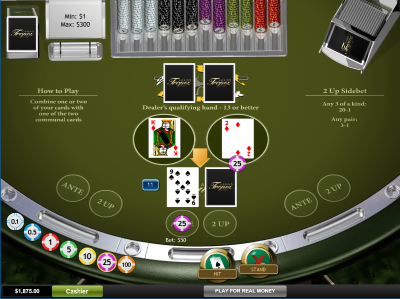
The game moved the $25 bet to the 9 card, to show that is what the player selected. Next comes the hit or stand decision. The obvious play with 11 is to hit. You can also see the player added the required $25 additional bet.
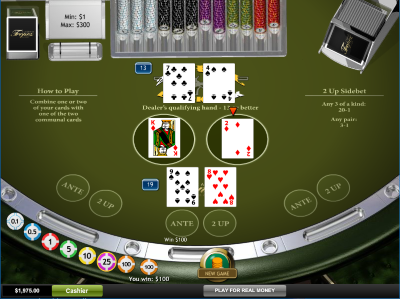
The player's third card was an 8, for a total of 19. It was then the dealer's turn. The dealer's starting card was a 7. Given the two community cards, he had the choice of two-card hands of 17 or 9. The house way above shows the dealer prefers a 9 to 17, so he chose the 2, for a total of 9. The dealer always hits 16 or less so he did. His third card was a 4, for a total of 13, which is enough to qualify. The player's 17 beat the dealer's 13 so both the original Ante and Raise bets paid 1 to 1, for a total win of $50.
Strategy
There are ten strategy tables, one for each initial player card. To use each table, look up the left card along the bottom row and the right card along the left column. A key follows the 10th table.
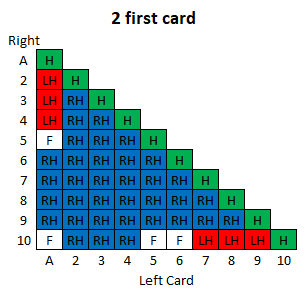 |
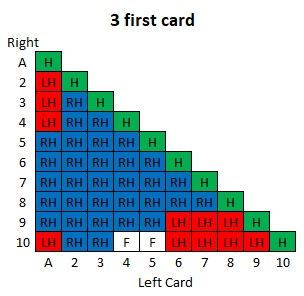 |
|
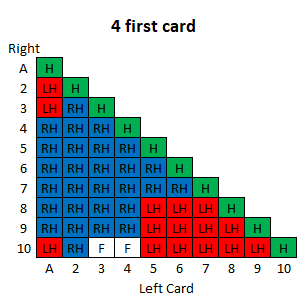 |
 |
|
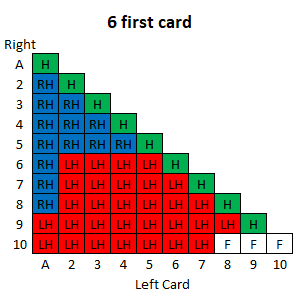 |
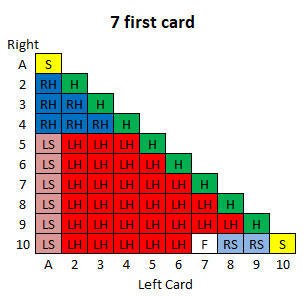 |
|
 |
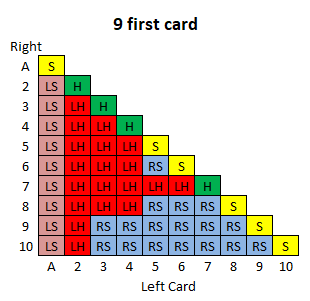 |
|
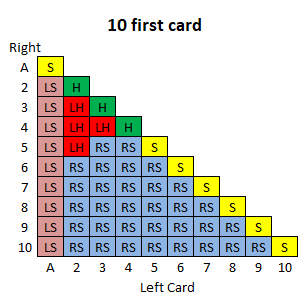 |
 |
Key to strategy tables:
- F = Fold
- H = Pick either card and hit
- LH = Pick left card and hit
- LS = Pick left card and stand
- RH = Pick right card and hit
- RS = Pick right card and stand
- S = Pick either card and stand
Analysis
The following table shows the probability and contribution to the return of all possible outcomes, based on the player strategy explained above.
21 Duel Analysis
| Event | Pays | Probability | Return |
|---|---|---|---|
| Player beats dealer | 2 | 0.314006 | 0.628012 |
| Dealer busts | 2 | 0.058887 | 0.117773 |
| Dealer doesn't qualify | 1 | 0.049477 | 0.049477 |
| Tie | 0 | 0.150751 | 0.000000 |
| Fold | -1 | 0.056932 | -0.056932 |
| Player busts | -2 | 0.059875 | -0.119751 |
| Dealer beats player | -2 | 0.310072 | -0.620145 |
| Total | 1.000000 | -0.001565 |
The lower right cell shows a house edge of 0.16%. The player will raise 94.31% of the time, for an average of 1.9431 units bet per hand. The Element of Risk, which is the ratio of the expected loss to total amount bet is 0.08%.
In all fairness, I should say that the help file for the game says, "The theoretical percentage return to player (RTP) is 98.38% on the main game." Until I get a trusted third opinion, you'll have to decide yourself who to believe.
2 Up
The following table shows my analysis of the 2 Up bet. The lower right cell shows a house edge of 6.53%.
2 Up Analysis
| Event | Pays | Combinations | Probability | Return |
|---|---|---|---|---|
| Three of a kind | 20 | 26,312 | 0.005248 | 0.104968 |
| Pair | 3 | 1,033,344 | 0.206120 | 0.618359 |
| Loser | -1 | 3,953,664 | 0.788632 | -0.788632 |
| Total | 5,013,320 | 1.000000 | -0.065304 |
Play for Fun
You can play for fun through this link to our sister site Latest Casino Bonuses.
Online Blackjack Casino Bonuses View All
Bonus Code
Same for Video Poker, Blackjack
- 40 times on Slots, Dragon Tiger
Bonus Code
Same for Blackjack, Video Poker
- 40 times on Parlor Games, Slots, Dragon Tiger
Bonus Code
Same for Blackjack, Video Poker
- 40 times on Parlor Games, Slots, Poker


.jpg)





